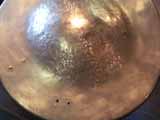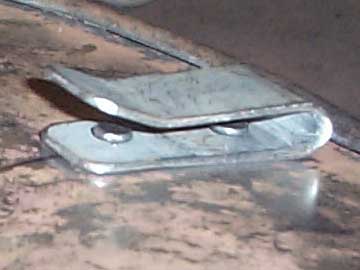Already dished and edges rolled, handle has been removed, but just started planishing.
See the many bumps in the middle. That's what I get for using an un-modified ball-peen hammer to dish it. Even a hammer ground down for dishing will give bumps, but they're more round and smooth. The round end of an off-the-shelf ball peen hammer is too pointy.The colours you see are an artifact of the mix of tungsten, fluorescent, and natural lighting
Inside, showing the rolled edge that I should have ground off evenly before closing it. Notice the gaps. When I cut out the circle, I used an electric shear. It was fast, but somewhat hard to control on curves, so it wasn't perfectly circular. When I had gotten as far as raising the rim to vertical (like a very shallow cake pan), what I should have done to fix it was to grind the top edge such that it was the same height all the way around. I didn't.
I cheated in the rolling by using a coathanger wire inside the roll, to help keep it from flattening and to keep a more-or-less consistent radius in the roll. One coathanger gave me just enough to make it around, with only 3 or 4 inches left over. I say "cheated" because one source maintains that armourers (in Period) did not use a wire core in rolled edges, and that surviving examples with wire cores are the result of repairs made in relatively recent times. The diameter of the roll is something like 5 mm (3/16")
Many rusty spots, probably from "Small Brawl At Summer's End" 2004.



